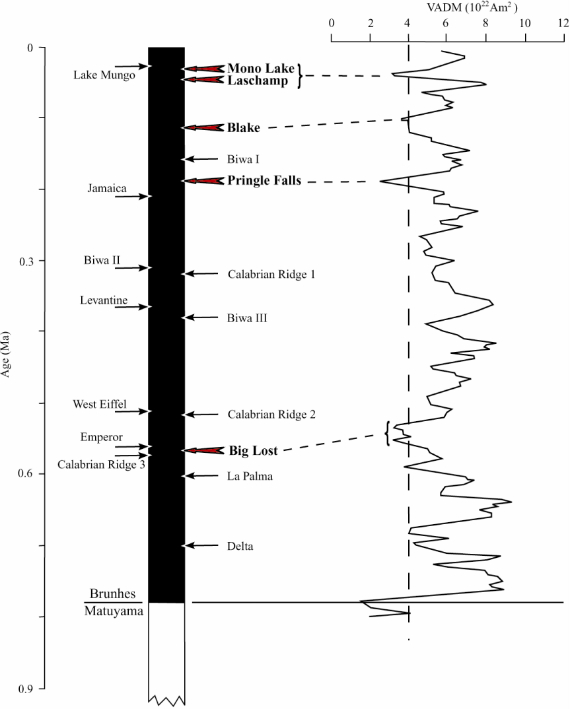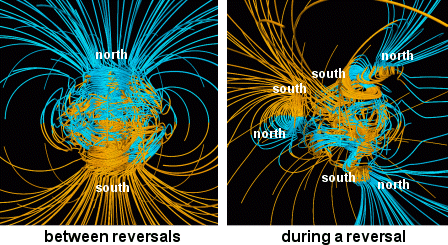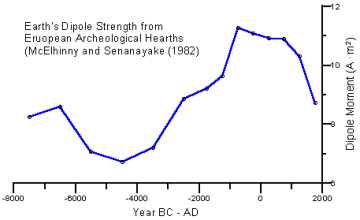Sometime in the next few thousand years, Earth's magnetic poles will reverse their polarity. Contrary to what doomsday advocates claim, it will hardly be noticed!
The main part of Earth's magnetic field is generated in the liquid, iron-nickel outer core of Earth, located 1,800 miles below our feet. This flow of molten, conducting material acts like the current in a wire and generates the geomagnetic field that extends over a million miles into space surrounding Earth. This field serves as a magnetic umbrella, protecting our atmosphere, expensive satellites, and astronauts working on the ISS from high-energy, charged particles from the Sun and deep space. Over billions of years, it also protects our atmosphere from literally evaporating into space, as happened on Mars!
Ch-ch-ch-ch-changes!
Geologic data going back over 100 million years shows that the magnetic polarity of Earth in the Northern Hemisphere has reversed about 170 times. However, the time between reversals tends to be random, so it is not a periodic phenomenon like the tick of a clock or the swing of a pendulum. They take between 200,000 and 1 million years, with a tendency for the most recent ones to take longer. The last major reversal, called the Brunhes-Matuyama Chron, happened about 781,000 years ago and led to the current magnetic polarity era we are living in. For the last 781,000 years, Earth's magnetic South Pole has been in the Arctic region of the Northern Hemisphere. That's why your compass points north, because opposite magnetic poles attract. It seems to take about 10,000 years or so for a major reversal event to establish itself.
Magnetic field changes during the last 800,000 years (credit: Edward Mankinen and Carl Wentworth/USGS via Wikimedia Commons)
The figure above shows the strength of Earth's magnetic field going back to the Brunhes-Matuyama reversal. It has increased and decreased in strength many times, while its polarity has globally remained the same. Although there is no scientific dispute about the origin of Earth's magnetic field, we don't fully understand exactly how the flows of molten material change over time. To some degree they seem to be chaotic, which causes minor ups and downs in the strength of Earth's field. If you look below the dashed line, there have been three times when the field decreased to half its maximum strength: the Big Lost Event 540,000 years ago, the Pringle Falls Event 190,000 years ago, and the Laschamp Event 41,000 years ago.
The Laschamp Event lasted about 440 years. During this time, Earth's field weakened to half its current level. To a geologist, this change happened fast! It only took about 250 years.
So What Happens During a Reversal?
Supercomputer simulations by University of California professor Gary Glatzmaier not only model Earth's magnetic strength and polarity changes but also show us how the polarity actually changes geographically. Major reversals take a few thousand years to complete, and during that time the magnetic field does not actually vanish; it just gets more complicated, like a checkerboard with many different polarities that come and go like clouds on a summer day.
Appearance of magnetic field before and during a reversal (credit: Gary Glatzmaier/Los Alamos National Laboratory)
As the figure above shows, magnetic lines of force near Earth's surface become twisted and tangled, and magnetic poles pop up in unaccustomed places. A south-type magnetic pole might emerge over Africa, for instance, or a north-type pole over Tahiti, but it's still a planetary magnetic field, and it still protects us from space radiation and solar storms. It's just that instead of seeing aurora only in the Arctic and Antarctic, you will see lovely displays over Hawaii or Venezuela too!
So What Is It Doing Lately?
The record of Earth's paleomagnetic field can be found "frozen" into solidified lava flows, or in pottery that has been heated up and then cooled after kiln drying. Archeologists have been able to recover this magnetic data for the last 10,000 years.
Most recent magnetic changes (figure based on Ilya Usoskin/Living Reviews in Solar Physics)
Although the pottery data points are about 500 years apart, we can see that the decline has picked up speed over the last 1,000 years. Direct daily and yearly measurements of magnetic field strength have now been determined from ship logs beginning in 1590 A.D., and from sensitive instruments since 1840, and tell a slightly different but nevertheless consistent tale. The current field did not change very much between 1590 and 1840, but since 1840 it has started a significant decline, by about 5 percent per century. This led to forecasts that in perhaps another 2,000 to 4,000 years we might be in the midst of another magnetic reversal. Unfortunately, we can't tell beforehand whether the change will be a short 400-year "excursion" like the Laschamp Event or one of the longer 10,000-year major transitions like Brunhes-Matuyama.
Map of geographic changes in geomagnetic field (credit: ESA/DTU Space/Swarm)
In 2014, data from the ESA Swarm spacecraft were presented in the June 19 conference on the mission's scientific results. The spacecraft had mapped the changes in Earth's magnetic field over a span of six months and found significant changes. The implication was that the decline is accelerating to perhaps 5 percent per decade. At the current pace, the reversal could happen in a century or so. So the bottom line is that Earth's field is currently declining in strength. This change is geographically complicated, and complicated in time, with some regions increasing and some decreasing in strength like the supercomputer models predict.
Whether the next major reversal happens in 100 years or 1,000 years we still can't tell for certain, but the effects will probably only impact migratory birds, whales and certain kinds of bacteria that navigate with the magnetic field. You and I will not notice much, except aurora in odd places of the world where they have not been sighted before. Ice-core data from Greenland shows that the Laschamp Event caused more cosmic rays to reach the atmosphere, but there is no evidence of species extinctions or other biological effects.
Fortunately, Earth's atmosphere is itself a far better shield for cosmic rays than its magnetic field!



